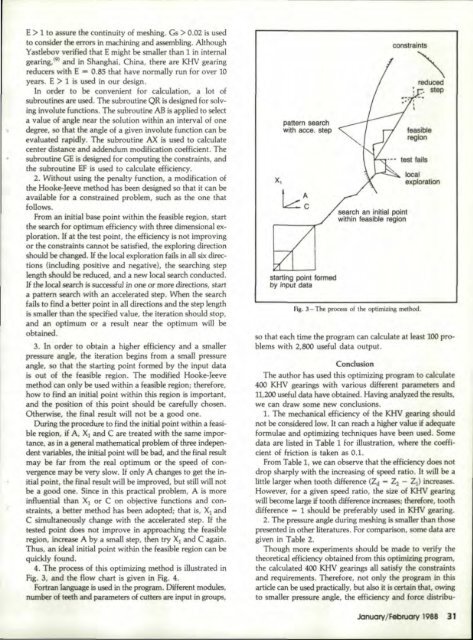Download PDF - Gear Technology magazine
Download PDF - Gear Technology magazine
Download PDF - Gear Technology magazine
You also want an ePaper? Increase the reach of your titles
YUMPU automatically turns print PDFs into web optimized ePapers that Google loves.
E > 1 to assure the continuity of meshing. 'Gs > 0.02 is used<br />
to consider theermrs in machining and assembling. Although<br />
Yastlebov verified thatE might besmaller than 1 in internal<br />
gearing,.(9J and in Shanghai, China, there are KHV gearing<br />
reducers with E 0.85 that have normally run for over 10<br />
years. E. > 1 is used in our design.<br />
In order to be 'convenient for calculation, a lot of<br />
subroudnesare used, The subroutine OR is designed forsolving<br />
involute functions. The subroutine AB is applied to select<br />
a value of angle near the solution within an in.terval of one<br />
degree, so' th~t the angle of a given involute function can. be<br />
evaluated rapidly. The subroutine AX is used to calculate<br />
center distance and addendum modification coefficient. The<br />
subroutine GE is designed for computing the constraints, and<br />
the submutine EF is used to calculate ,efficiem:y.<br />
2. Without using the penalty function, a modification of<br />
the Heeke-Ieeve method has been designed so 'that it can be<br />
available for a constrained problem, such as 'the one that<br />
foUows.<br />
From an initial base point within the feasible region,start<br />
the search for optimum efficiency with three dimensional exploration.<br />
U at the test point, the ,efficiency is not improving<br />
or the oonstraints cannot be sarisfied, the exploring direction<br />
should be changed. If the local exploration fails in an six direc~<br />
tions (including positive and negative), Lhe searching step<br />
length should be reduced. and a new local search conducted.<br />
If the local search is successful in one or more directions, start<br />
a. pattern searehwithanaccelerated step. When the search<br />
fails to find a better point in all dil'ectionsand the step length<br />
is smaller than the specified value, the iteration should stop,<br />
and an optimum or a result near the optimum will be<br />
obtained.<br />
3. In order to obtain a higher eff:idencyanda smaller<br />
pressure angle, theil:eration begins from a small pressure<br />
angle, so that the starting point formed by the input data<br />
is 'out of the feasible region. The modified Hooke-Ieeve<br />
method can only be used within a feasible region; therefore,<br />
how to find an initial point w:ithinthis region is important,<br />
and the position ·of this poin.t should be carefuJ1y chosen.<br />
Otherwise, the final result will not be a good one.<br />
During 'the procedure to find the initial point within a feasible<br />
region, if A, Xl and C are 'treated with 'the same importanoe,<br />
as in a genera] mathematical problem of three independent<br />
variables, the initia] point will be bad, and the final result<br />
may be far from the real. optimum or the speed of convergence<br />
may be very slow. H only A changes !to get the initiaIDpoint,<br />
the final result will be improved, but still. will not<br />
be a good one. Since in this practical problem, A is more<br />
influential than Xl or C on objecti.ve functions and constraints,<br />
a better method has been adopted; that is, Xl and<br />
C simul:t:aneously changewi.th the accelerated step. If the<br />
tested point does not improve in approaching the feasible<br />
region, increase A by a. small step, 'th.en try Xl and C again.<br />
Thus, an ideal injtial point w:ithin the feasible region can be<br />
quicldy found.<br />
4. The process of 'this ,optimizing method is illustrated in<br />
fig. 3, and the flow chart is given in. Fig. 4.<br />
Fortran Wanguageis used in the program. Dilierent modules,<br />
number of 'teeth and parameters of 'cutters are input in groups,<br />
pattern search<br />
with aces ..step<br />
Xl<br />
fLA<br />
-- C<br />
starting point formed<br />
by input dala<br />
constraints<br />
search an Initial !pOint<br />
within feasible' region<br />
feasible<br />
Ireglon<br />
.FIg, 3 - The process of the optimizin,g m lhod.<br />
at least 100 pro-<br />
so that each time the pr1>gram can calculate<br />
blemswith 2,800 useful data output.<br />
Conclusion<br />
The author has used thlsophmizi,ng program to calculate<br />
400 KHV geariJl-8s with various different parameters and<br />
11,200 useful data have obtained ..Having .analyzed the results,<br />
we can draw some new condusions.<br />
1. The mechanical 'efficiency of the KHV gearing shoul:d<br />
not be considered low. mt.can reach a higheT value if adequa'te<br />
formulae and optimizing techniq-ues have been used. Some<br />
data are listed in Table 1 for illustration, where the coefficient<br />
of friction is 'taken as 0.1.<br />
From Table 1, we can. observe Ithat the efficiency does not<br />
drop sharply with 'the increasing of speed ratio. It will be a<br />
little larger when tooth difference (Zo - Zz - Zi) increases.<br />
However, for a given. speed ratio, the size of KHV gearing<br />
will becorne brge if ,tooth difference increases; Itherefore, tooth<br />
difference - 1 should be preferably used in KHV gearing.<br />
2. The pressure angle during meshing is smaller than those<br />
presented in other literatures. For comparison, some data are<br />
given in Table 2.<br />
Though more experiments should be made to verify the<br />
theoretical effidency obtained from this optimizing program,<br />
the calculated 400 KHV gearings all satisfy the constraints<br />
and requirements. Therefore, not only the program in this<br />
article can be used practically, but also it is certain that, ,owing<br />
to, smaller pressure angle, the efficiency and force distribu-<br />
January/February 1988, 31

















